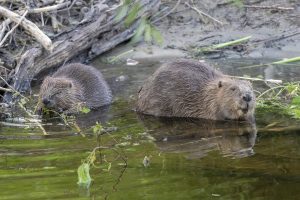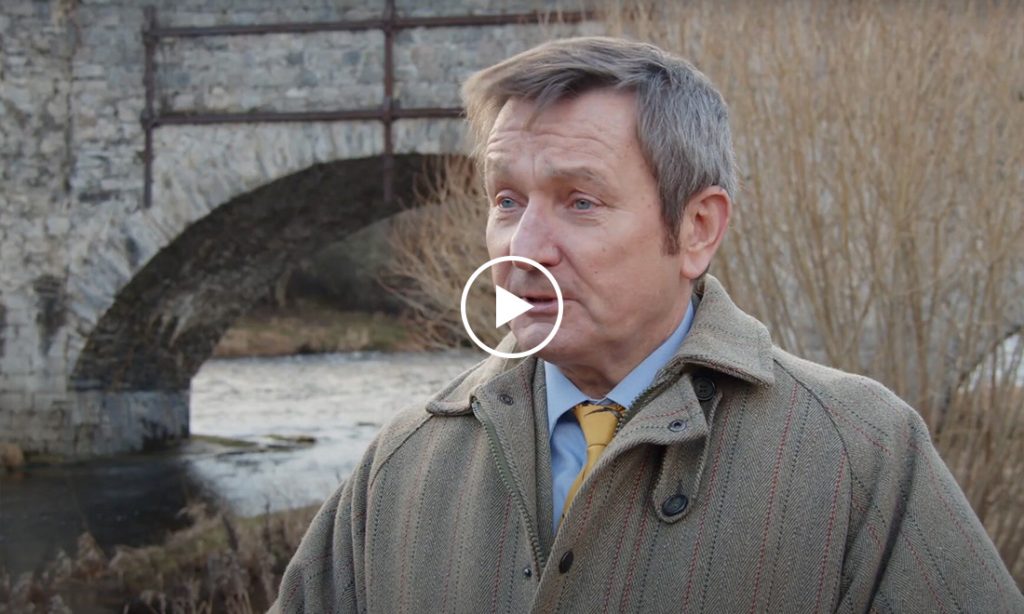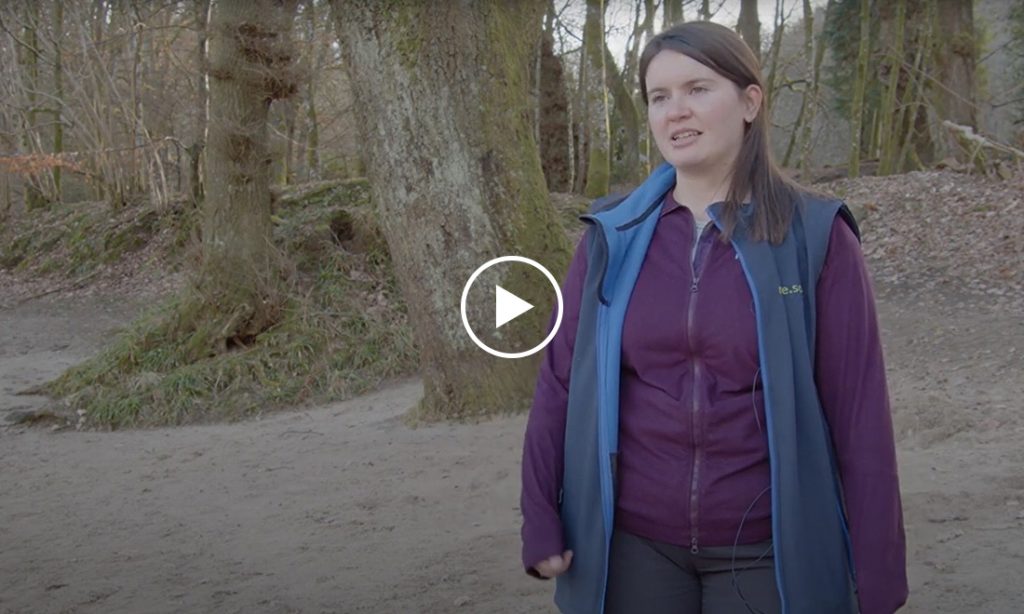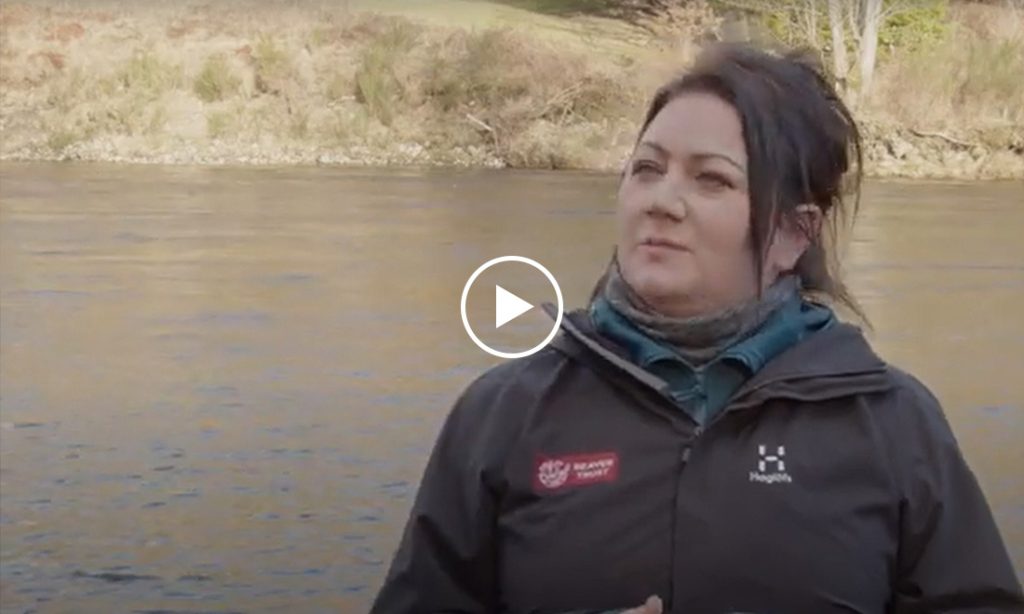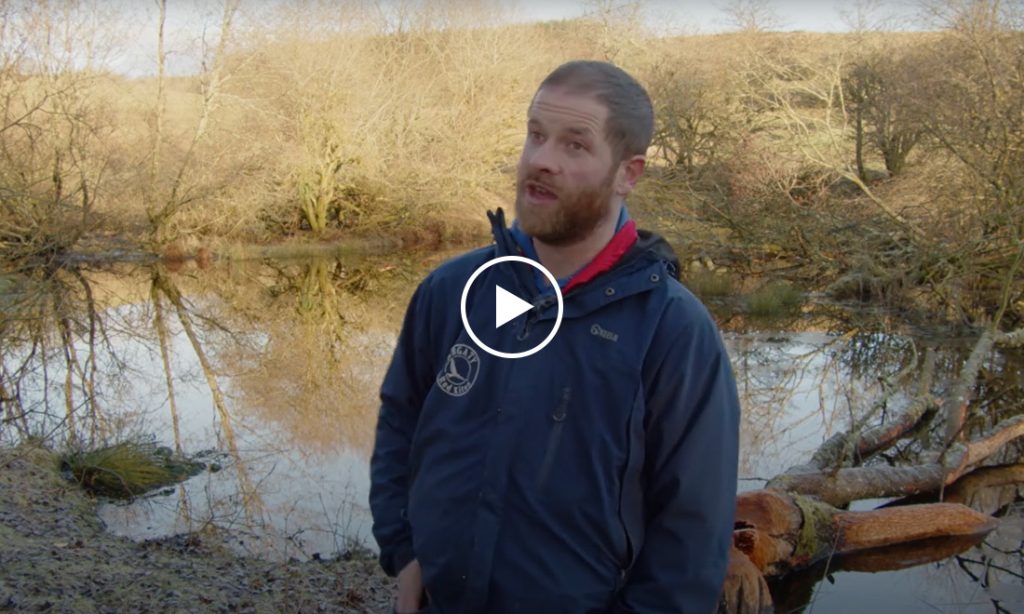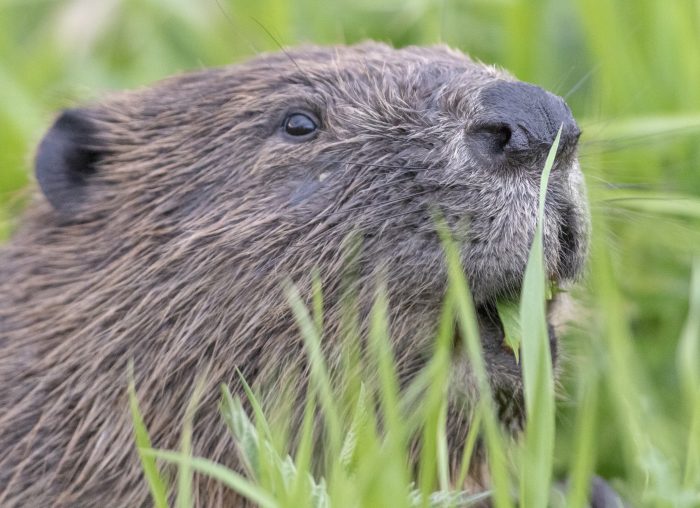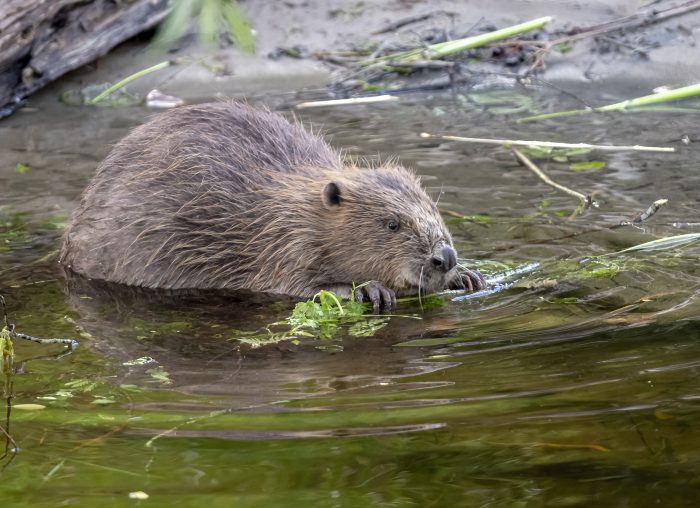Beavers
On these webpages you will find all the information you need on our proposal to bring beavers back to the Cairngorms National Park
Bringing beavers back to the Cairngorms

Watch this short video to hear Dr Sarah Henshall, Head of Conservation at the Park Authority, explain the background to the project and what we're proposing here in the Cairngorms.
Watch video on YouTubeBeavers are nature’s engineers. By changing and renaturalising the landscape around them, they can help us combat climate change and boost biodiversity. From coppicing trees to damming smaller water courses and creating narrow canals, beavers create the ideal habitat for species such as frogs and toads, otters, water voles, dragonflies and birds.
Their actions also benefit people, creating and expanding wetlands that act like a sponge to hold back water, reduce downstream flooding and store carbon. Beaver dams have also been shown to improve water quality, reducing the effects of agricultural run-off and harmful chemicals on the water supply.
Whilst beavers can bring a range of benefits, if not managed effectively their activities could have negative impacts too, on farm businesses and fishing interests in particular. It’s important we use all the evidence gathered and experiences we have heard to make sure the Park Authority is there to support land managers and deal with any issues quickly and effectively.
Our vision of people and nature thriving together is:
“a healthy population of beavers in the Cairngorms National Park, bringing maximum benefits for wildlife and people. This includes supporting land managers and communities to live alongside beavers.”
Dr Sarah Henshall – Head of Conservation, Cairngorms National Park Authority
If you would like to find out more about living alongside beavers and how the Park Authority can help, get in touch with Jonathan Willet, Beaver Project Manager at [email protected].
The Park Authority is committed to supporting land managers in living alongside beavers. As the licence applicant we will provide additional resource and be the primary point of contact for mitigation and management in the National Park. The additional support being offered to businesses, landowners and the general public within the Park includes:
- Single, named point of contact within the Park Authority, the Beaver Project Manager
- Access to additional staff and volunteers to undertake monitoring
- Regular monitoring undertaken to detect the range and spread of beavers within the National Park boundary
- Dialogue with landowners / managers and the public the Park Authority to identify and map areas of high-impact
- Continued development of the list of potentially high-impact sites
- Extensive proactive monitoring will be undertaken on high-impact sites when beaver presence is detected
- Landowners / managers contacted when beaver signs are detected on their land
- Quick responses to requests for site visits
- The Park Authority will offer to make, on behalf of the landowner / manager, any European Protected Species licence application that is required for mitigation works
- Additional budget provided by the Park Authority, as the licence applicant, to fund small-scale mitigation activities and remedial works not covered by the national mitigation scheme, to be agreed between the landowner / manager and the Park Authority on a case-by-case basis
A full description of the mitigation options and Park Authority support available can be found by clicking here
A letter to the Spey Crofters and Farmers group from Grant Moir, CEO of Cairngorms National Park Authority, can be found by clicking here
Where are we now?
On Tuesday 5 December, we welcomed NatureScot’s announcement approving our application for a licence to translocate beavers to the Upper Spey catchment in the National Park. This will be the first out of range translocation in Scotland and will make a significant contribution to the delivery of the Scottish Beaver Strategy.
We submitted the licence application in October, following extensive consultation with the agricultural community, fishing interests, the public and other key stakeholders. You can view the licence application documents below.
The translocation licence from NatureScot allows for up to six beaver families to be released in the Upper Spey catchment in the first year. The first three release sites are on land owned by Rothiemurchus Estate, Wildland Scotland and RSPB Scotland, and we are working closely with these partners to progress with the first releases in the coming weeks and months.
Our beavers will be coming from the Tay Catchment and will be trapped under licence by The Beaver Trust. They will go through health checks and will then be transported to their release sites in the Cairngorms National Park soon after.
We will be undertaking careful monitoring of these sites, and our monitoring programme will involve visiting the release sites and any high-risk habitats or infrastructure to ensure there are either no issues or we can act quickly to ensure any issue doesn’t escalate.
If the landowners are agreeable, we are keen that any mitigation sites present on their land that are successful become promotable demonstration sites. NatureScot are supportive of this approach. The Park Authority are also keen to provide training, in partnership with NatureScot and the Beaver Trust, on undertaking these mitigation techniques and licencing individuals to undertake them.
Over the coming weeks and months we are also going to be undertaking baseline surveys on some of the flood banks and in line with ongoing work with landowners and farmers. You can find out more about our mitigation and support available in the section above.
What is planned and who’s involved?
The Cairngorms National Park Authority has been working closely with a range of partners and land managers on a carefully considered proposal to reintroduce beavers to the upper Spey catchment to create a self-sustaining population of beavers in the Spey catchment.
We have been working closely with the Cairngorms Beaver Group to take this work forward. The group was established in 2017 to advise and plan for the arrival of beavers to the National Park and includes representatives from a wide range of backgrounds and sectors, including land management conservation bodies, fisheries and farmers. Members include the Cairngorms National Park Authority, National Farmers Union of Scotland, Scottish Land and Estates, Spey Fishery Board, Spey Catchment Initiative, Dee Catchment Partnership, River Dee Trust, River South Esk Catchment Partnership, Forest and Land Scotland, RSPB Scotland and NatureScot.
Over the last 12 months we have been listening and learning about the opportunities and issues beavers can bring. Speaking to land managers and farmers living alongside beavers, and those who have gone through the process of translocating beavers. We have been undertaking sites visits in the upper Spey catchment, having conversations with private landowners, businesses, community interests and have had extensive engagement with release site owners. As part of ongoing farm visits our Farmland Conservation Advisor has also been speaking with farmers in Badenoch and Strathspey about beavers.
We have also sought expert advice from the Beaver Trust on habitat modelling, the suitability of release sites and providing information at public events. The beavers will be translocated into sites which have been identified as having enough high quality habitat to give the best chance of the released beaver families settling there. Three initial release sites have been agreed at Rothiemurchus, Wildland Cairngorms and RSPB Scotland Insh Marshes. In collaboration with land managers and communities we will then plan further releases within the catchment over the next few years to ensure there are enough for a viable population.
- The Cairngorms National Park Authority will lead and coordinate a project to bring beavers back to the Cairngorms National Park.
- The Spey will be the first catchment the project will focus on, after a review of the population status of the released beavers, a timetable for proposed releases to other catchments in the Cairngorms will be developed.
- Subject to a licence being granted by NatureScot the Park Authority will work with landowners to release a number of beaver families, over the 5-year licencing period, into suitable habitat in the Upper Spey as a founder population.
- An initial three sites have been agreed with Rothiemurchus Estate, Wildland Cairngorms and RSPB Scotland Insh Marshes and all have waterbodies and wetlands with enough summer grazing and winter browsing to give the best chance of the released beaver family settling there.
- There will be sufficient families released to establish a self-sustaining population that will colonise the Spey catchment over time.
- The Park Authority, working with other partners will monitor the released beavers and regularly report on what they are doing.
- Accepting some impacts but acting when those impacts become unacceptable (defined by NatureScot as those that damage property or infrastructure, or cause significant problems for land management).
- The Park Authority will be the first point of contact for dealing any issues caused by the beavers.
- The activities of beavers will complement the Spey Catchment Initiative, which seeks to facilitate large-scale habitat restoration of the Spey.
- We have taken expert advice from the Beaver Trust on habitat modelling, the suitability of release sites and providing information at public events.
Bringing beavers back
Listen to key stakeholders and experts’ thoughts and information about bringing beavers back to the Cairngorms National Park, benefits, potential impacts, and mitigation.
Roger Knight, Chairman of the Spey Fishery Board – giving his thoughts on beavers and fish, Kirsten Brewster – talking about NatureScot’s beaver mitigation strategy, Dr Roisin Campbell-Palmer, Head of Restoration at the Beaver Trust – giving her expert opinion and sharing her wealth of experience and Tom Bowser of Argaty Red Kites – talking about the positive changes they have seen to their wetlands following the translocation of beavers to the farm in Doune.
Visit our YouTube channel to also see Dr Peter Cosgrove, one of the UK’s leading freshwater pearl mussel experts – on the interactions between beavers and mussels, and Dr Sarah Henshall, Head of Conservation for the Park Authority talking about the beaver project as a whole.
What’s happened so far?
Over the last year, we have undertaken extensive engagement with key stakeholders, communities, land owners, land managers, businesses and organisations.
Our public engagement began in March 2023 with an informal engagement programme including four events, Beaver Blethers, – two in Kincraig, one in Kingussie and one in Aviemore – to discuss our plans for beavers in more detail. The 2023 Beaver Blethers Report stated over 80 people attended four events, the views expressed were generally supportive of beavers coming back, and specific local concerns were recorded so that they could be addressed.
Throughout the year we have also offered site visits for concerned landowners and land managers. Since coming into post in mid-March 2023, the Beaver Project Manager has undertaken 18 site visits to discuss potential beaver impacts with various landowners and organisations, and these continue to be offered to anyone who would like to specific and local advice.
Specific meetings with key stakeholder groups and visits to sites with beavers were arranged to allow for in depth conversations and questions to be answered.
In August the formal engagement period, gathering the thoughts and opinions of people on the proposals for inclusion in the licence application, took place from 14 August – 25 September. The six week formal engagement period included an online questionnaire, six public events, 1:1 site visits and key stakeholder meetings. The public events took place in Badenoch and Strathspey and Aberlour with specific events targeted at key communities including land managers, farmers, other businesses, residents and those with fishing interests, and were attended by over 100 people in total. Comments were gathered in person and digitally through an online questionnaire which received over 500 responses and revealed:
- Over two thirds of respondents were strongly in favour of returning beavers to the Cairngorms National Park.
- Nearly three quarters were favourable in some way.
- Around a third of responses were from Cairngorms National Park residents.
- A report on the results of this engagement was submitted as part of the licence application to NatureScot and can be viewed under Appendix 8 in the licence documents below.
Sarah Henshall, Head of Conservation: “Our sincere thanks to everyone who took the time to come to one of our public engagement events or who took the time to comment online on the proposals – with 500 comments received. And a massive thank you to all the partners who helped make these events a success.”
We submitted our beaver translocation licence application to NatureScot on 20 October 2023. You can view our licence application documents through the links below.
All of the following documents were submitted to NatureScot as part of the licence application. Some sections have been redacted to protect people’s identities and the locations of the specific release sites.
- Scottish Code for Conservation Translocations – project proposal form
- List of appendices
- Appendix 1 – Assessment of the potential for Eurasian beavers to naturally colonise the Cairngorms National Park
- Appendix 2 – Spey catchment: beaver feasibility and potential release site assessment
- Appendix 2.1 – RSPB Scotland site selection strategy
- Appendix 2.2 – Additional release site information
- Appendix 3 – SSSI consent for beaver release
- Appendix 4 – Email correspondence with [redacted] and other farmers in the Nethy Bridge area
- Appendix 5 – Response to [redacted]’s questions
- Appendix 6 – Note of Nethy Bridge and Laggan meetings
- Appendix 6.1 – [redacted] email
- Appendix 6.2 – [redacted] email
- Appendix 6.3 – [redacted] email
- Appendix 6.4 – RSPB Scotland’s engagement record
- Appendix 7 – Our approach to communications
- Appendix 8 – Engagement report
- Appendix 9 – March 2023 beaver blethers report
- Appendix 10 – Formal engagement event responses
- Appendix 11 – NFUS beaver response
- Appendix 12 – Nethy Bridge and Vicinity Community Council response
- Appendix 13 – Online engagement survey comments
- Appendix 14 – Monitoring and mitigation plan 2023
In 2019, beavers were formally recognised as a European Protected Species by the Scottish Government, and allowed to expand naturally within their current range.
In 2021, the Scottish Government announced a change in policy, actively promoting translocation (ie carefully moving animals from one location to another) to support the expansion of the beaver population into new catchments.
In June 2022, the Park Authority board agreed that the Park Authority would take the lead on reintroducing beavers to the Cairngorms, coordinating and facilitating the process with a range of partners and key stakeholders.
In August 2022, the National Park Partnership Plan was published, this commits us to facilitating beaver translocation to the Cairngorms National Park by 2027.
In September 2022, NatureScot published the National Beaver Strategy 2022-2045, engaging over 50 different stakeholders to help shape a vision for the future of the species in Scotland.
In 2022, Lorna Slater MSP, Minister for Green Skills, Circular Economy and Biodiversity, set out Scottish Government’s clear ambition for beavers to be translocated to the Cairngorms National Park by 2024.
In February of this year, the Park Authority recruited a full-time Beaver Officer to focus on all aspects of successfully bringing beaver back to the Park and lead the project. A key part of this post is to support local land managers and the wider community throughout this whole process and beyond. Over the past months this work has included conversations and site visits with the Park Authority’s Farmland Conservation Advisor to landowners and farmers around the upper Spey area. Our commissioned report identified this as the most suitable habitat for beavers.
In March, we held four public engagement sessions, Beaver Blethers, to discuss our plans for beavers in more detail. The 2023 Beaver Blethers Report stated over 80 people attended four events, the views expressed were generally supportive of beavers coming back, and specific local concerns were recorded so that they can be addressed.
In April and May the Beaver Trust undertook surveys to identify suitable sites in the upper Spey to translocate beaver families to.
In June, NatureScot produced an Environmental Report for the Strategic Environmental Assessment of beaver returning to the Spey catchment. The assessment includes the identification of risks and constraints of beaver translocation to other interests (habitats, species, migratory fish, land management, infrastructure). The report has been published and the consultation on this document ended at the end of July. This critical piece of work is essential to informing our engagement process and the monitoring of protected sites required by NatureScot.
This report includes modelling of release site scenarios in the upper Spey catchment to understand population growth and dispersal. The modelling scenarios are based on five and ten beaver families over ten years. These are presented in the Section 1.1 of the Environmental Report. We will use this information to identify potential impacts and inform our monitoring plan. We also have maps for the whole of the upper Spey catchment which show suitable beaver habitat and potential dam capacity.
A full timeline of our project can be found in the Frequently Asked Questions (FAQs) section below. Keep an eye on our website, social media and local press for further updates, or get in touch with us by emailing [email protected].
“30% of the National Park watercourses are highly suitable for beavers and 20% are suitable for beaver dams. The most appropriate habitat for beavers is the network of lochans and wetland environments largely in the complex of wetlands and lochans in the upper Spey catchment.”
Frequently asked questions
Beavers are the largest rodent native to Europe. They have thick brown fur, scaly tails and webbed hind-feet. Adults can measure over a metre from head to tail (about the size of a small Labrador!).
Beavers are known for their large front teeth, which they use to cut through tough woody vegetation. Iron in their tooth enamel gives the teeth an orange colour and makes them strong. The teeth stick out in front of their lips to allow beavers to chew underwater.
Beavers are herbivores. They eat leaves, bark, twigs, roots and aquatic plants. Whilst they do fell trees, they do not eat wood – instead, they eat the cellulose underneath the bark and use the wood to build dams and lodges. Beavers do not eat fish.
Beavers build lodges out of woody debris, twigs and soil. Lodges are accessed via water-filled tunnels which keep the beavers safe from predators. Beavers eat, sleep, keep warm and raise their young (kits) in lodges. They also use them as food stores to keep them going during winter months.
Beavers don’t always live in lodges, though; sometimes they create burrows in the banks of rivers. These can extend for several metres and contain one or more chambers. Burrows will usually have one or more entrances below the water’s surface.
Beaver dams are impressive structures made out of wood, mud and stones usually built on shallow rivers, streams and ditches. Dams are constructed by beavers to create suitable living conditions where they are protected from predators.
Dams are constructed by beavers to create suitable living conditions where they are protected from predators, allowing them to move wherever they wish without leaving the water (via water-filled channels and pools). Dams slow the flow of water and create areas of deeper water which are ideal for beaver lodges. Water permeates through the dam and when deep enough will also overtop and flow around the sides of the dam.
Beaver build dams in narrower, slower-flowing streams rather than broad, fast-flowing rivers. Most dams are therefore built on narrower streams and it is unusual for dams to be built on rivers wider than six metres. It is extremely unlikely that beavers will dam the Spey as it is too large and fast flowing. Our independent research suggests that only around 20% of watercourses in the Cairngorms are suitable for damming by beavers.
There are two distinct populations of beavers in Scotland at present. The first, smaller population is in Knapdale, mid-Argyll, which is a result of the Scottish Beaver Trial which ran from 2009 to 2014. A second, much bigger population exists further east in the Tay and Earn catchments, derived from accidental or illegal releases in the early 2000s.
NatureScot has approved two applications to move beavers within individual catchments: one in Argaty in Perthshire and another in Loch Lomond (Trees for Life are also undertaking a consultation process that may lead to a translocation application on behalf of a group of landowners in Glen Affric and Strathglass).
Beavers are fantastic ‘ecosystem engineers’, a term we use to describe their ability to modify the environment around them. Beavers have an extraordinary ability to make changes to their habitats, such as coppicing trees and shrubs, damming smaller water courses, and digging ‘beaver canal’ systems. These activities create diverse and dynamic wetlands – helping to reconnect floodplains with their watercourses. In turn, these wetlands can bring enormous benefits for biodiversity and people as well as sequestering carbon. In the Cairngorms National Park, much of our river catchment restoration work centres around restoring wetland habitats, creating native woodland, re-naturalising our rivers– all work that beavers have the ability to do naturally and for free!
Read more: Research Article – Beaver: Nature’s ecosystem engineers (wiley.com)
The Eurasian beaver (Castor fiber) was once widespread across the UK and the rest of Europe, playing a vital part in the natural functioning of ecosystems that shaped the landscape for generations. The species was hunted extensively for its fur, meat and for a secretion called ‘castoreum’ (used in perfumes, food and medicine), resulting in its extinction in the UK in the 16th century.
It wasn’t until 2009 – when a small population of beavers was reintroduced in Knapdale, mid-Argyll as part of the Scottish Beaver Trial – that the species returned to our shores. Following a successful five-year scientific trial, the beaver was given European Protected Species status in Scotland in 2019.
Below is a list of key dates in the story of beavers to date:
- 2009 – Beavers are reintroduced to Scotland in Knapdale, mid-Argyll by Scottish Beaver Trial partners the Scottish Wildlife Trust, Royal Zoological Society of Scotland, Forestry and Land Scotland and NatureScot.
- 2012 – The Tayside Beaver Study Group is created in response to a decision by The Scottish Government to tolerate an unlicensed beaver population on Tayside. The Tayside population was allowed to remain in place for the remainder of the Scottish Beaver Trial so the two populations could be studied side-by-side.
- 2015 – Final reports are prepared for Scottish Government on the Scottish Beaver Trial and the results of the Tayside Beaver Study Group’s activities. These reports would help inform a decision on the long-term future of the species in Scotland.
- 2016 – Scottish Government announced in November 2016 that beavers would remain in Scotland.
- 2017 – The Park Authority set up a Cairngorms Beaver Group, made up of representatives from the land management, fisheries, public and third sectors.
- 2019 – Beavers are formally recognised as a European Protected Species by the Scottish Government, allowed to expand naturally within their current range.
- 2021 – The Scottish Government announced a change in policy, actively promoting translocation (ie carefully moving animals from one location to another) to support the expansion of the beaver population into new catchments.
- 2021 – The Park Authority commissioned a Beaver Trust study on the likelihood of beavers arriving to the Cairngorms National Park naturally, together with the identification of potential benefits, implications and habitat suitability.
- 2022 – Minister for Green Skills, Circular Economy and Biodiversity, Lorna Slater MSP, set out Scottish Government’s clear ambition for beavers to be translocated to the Cairngorms National Park by 2024.
- 2022 – In June, the Park Authority board agreed that the Park Authority would take the lead on reintroducing beavers to the Cairngorms, coordinating and facilitating the process with a range of partners and key stakeholders.
- 2022 – In August, the National Park Partnership Plan was published, this outlines our commitment to facilitate beaver translocation to the Cairngorms National Park by 2027
- 2022 – In September, NatureScot published the National Beaver Strategy 2022-2025, engaging over 50 different stakeholders to help shape a vision for the future of the species in Scotland.
- 2023 – In February, the Park Authority recruited a full-time Beaver Officer to work with partners to bring beavers back to the Cairngorms.
Benefits of beavers
We are in the midst of a climate and nature crisis and beavers can actively manage and restore ecosystems to tackle both climate change and biodiversity loss. Beaver dams hold back and store water, reducing flow downstream and helping store water in the catchment, increasing drought resilience. It’s been proven that healthy wetlands are more effective at absorbing and storing carbon than forestry plantations, so having healthy, well-managed wetlands is important in our fight towards tackling the climate and nature crisis. Beavers are a crucial piece of the jigsaw in helping us achieve this.
The mosaic of freshwater habitats from ponds, wetlands and canals created by beavers support a diversity of plant, amphibian, fish, invertebrate and bird life. Beavers have been proven to bring ecotourism and education benefits, including opportunities for guided tours to see the habitats they create and, if you’re lucky, a glimpse of the charismatic creatures too.
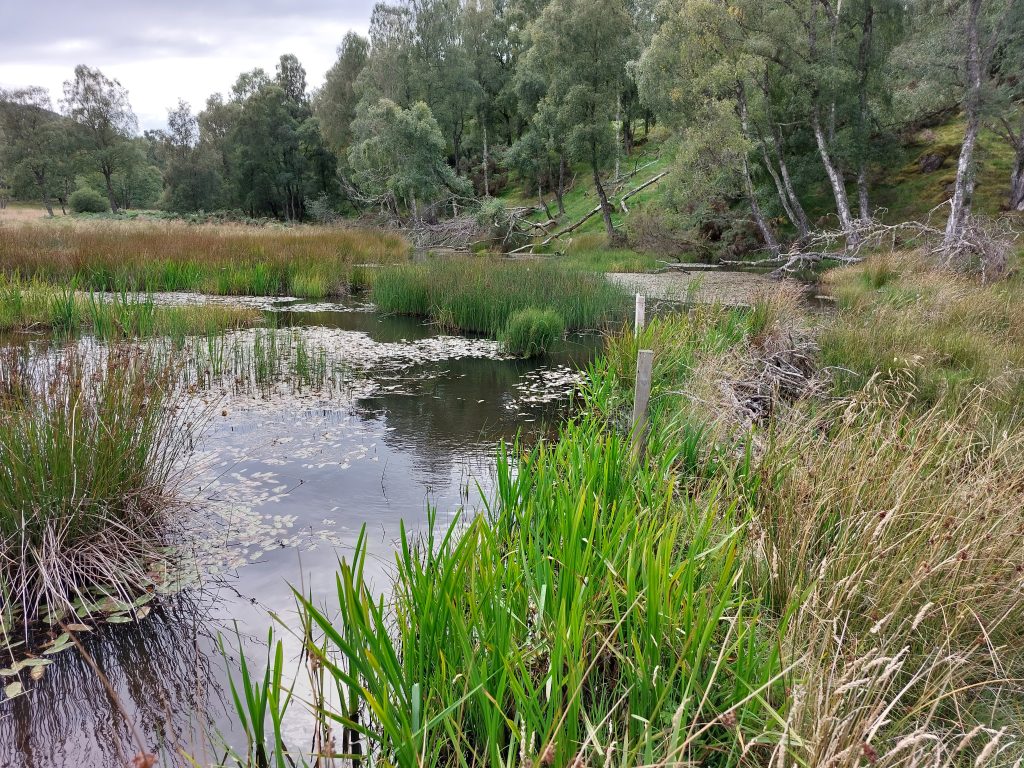
What potential impacts can beavers have and how can they be mitigated?
The impacts of beavers depend on the habitats the locations that beavers decide to set up a territory in. The impacts can vary from negligible to unacceptable. As defined by NatureScot they are ‘those that damage property or infrastructure or cause significant problems for land management.’
NatureScot operates a fully resourced advice and management approach for identifying and delivering action on the ground to manage and mitigate impacts from beavers on land management. A staff team is available to provide advice, visit situations on the ground, assess the level of impact, and where required, implement practical steps to address beaver-related issues. This framework is fully supported by The Scottish Government and is not time limited.
We’ve carefully chosen the release locations to minimise potential negative impacts. Over time the beavers’ territories and population will expand and will have greater impacts, both positive and negative, the magnitude of which will be site specific. We are already working with stakeholders to identify, mitigate and develop robust monitoring to identify and address concerns, for example, the Cairngorms Aspen Group and the Spey Fishery Board.
Through extensive engagement with land managers and stakeholders we have identified the potential impacts beavers could have in the Spey Catchment within the National Park. We have summarised the potential impacts of beavers, the national mitigation scheme measures and our proposed actions in a summary document, click here to view.
Beaver dams can cause small-scale localised flooding. Where narrow channels or ditches are dammed, water can build up behind and spread onto the neighbouring ground, especially where the stream banks are low. While this can create valuable wetland habitat, it can also cause problems by flooding high value farmland, as has happened in the lower reaches of the Tay catchment, where beavers have dammed drainage ditches running between low-lying crop fields. However, the Spey is a very different catchment to the Tay.
There are well-established methods for mitigating the impacts of localised flooding. Flow devices can be installed (which lower the water in a pond behind a beaver dam whilst allowing beavers to continue dam building), or dams can be notched or even removed depending on the site under licence.
Beavers can burrow into riverbanks to create lodges with underwater access where the conditions are right. They prefer well-wooded banks beside quieter backwaters with low-energy water flows for this. Burrows may extend a few metres under the bank, which can undermine the ground above, especially where it is used by cattle or farm machinery. On the Spey, much of the flood bank Is set well back from the river making it unsuitable for beavers to create burrows. However, in some areas it is much closer. In these areas mapping work is being undertaken to establish the proximity of flood banks to the river along with an assessment of condition, establishing the current baseline.
Creating strips of riparian woodland along banks that might be vulnerable to burrowing can go a long way to securing them against damage. The binding effects of vegetation and the limited use by livestock protect the bank from erosion. If areas of the bank with a high likelihood of burrowing are identified, in some circumstances they can be safeguarded with willow ‘spiling’ or metal anti-burrowing grids.
Long-term beaver management is best focused where practicable on setting back embankments, creating space for beavers and natural river processes, and through the establishment or regeneration of riparian buffer zones with native vegetation and trees along the rivers, streams and ditches to help stabilise river banks.
As beaver create complex wetlands, they produce more and different places for fish and their prey to live. Studies have shown that young brown trout thrive in beaver wetlands.
Beaver impact on the main channel of the Spey will be limited, as they will not dam the river as it is too wide and deep. Concern has been raised regarding damming of spawning streams affecting the redds and impacts on the timing of adult salmon moving upstream to spawn. Salmon and sea trout use small burns to reach their spawning grounds. Access to these areas is therefore vital in maintaining healthy wild fish populations. Fish have swum through, round and over beaver dams for thousands of years; however, in dry periods, low water levels can temporarily prevent adult salmon and trout from jumping dams to access their spawning areas.
Working with the Spey Fisheries Board we have identified potentially sensitive sites by overlaying redd data with Beaver Damming Capacity mapping. After the initial translocation, any damming of spawning burns will be closely monitored to identify if there are any impacts on adult fish migration and, if required, appropriate mitigation undertaken e.g. dam notching.
We commissioned Dr Rachel Malison at the Flathead Lake Bio Station in Montana to record the talk she gave to the Beaver Conference that was held in Exeter this April. This was an extensive review of the literature relating to fish and beaver interactions. In summary, her presentation states beavers and salmon have co-evolved, local context is very important, the ecological systems are complex and hard to generalise, but positive interactions of beaver and fish generally outweigh the negative.
The talk can be viewed by clicking here and it is 42 minutes long. The list of references (11 pages) can be accessed by clicking here.
Native tree species like willow and alder which have evolved alongside beavers over millions of years do not die when felled. They coppice, re-rooting from felled stems or debarked cuttings and grow rapidly. Aspen suckers after felling. Non-native species such as beech and cedar will die if felled but they are not the preferred species of choice for beavers. If felled, the deadwood will provide a home for over 2,000 species of invertebrates, a shelter for fish to rest or hide from predators and perches for many species of birds including kingfishers. Ninety percent of beaver activity is within 20-30 metres of the watercourse. We are working with the Cairngorms Aspen Group to identify vulnerable stands of aspen and where protection or establishment of new stands is required.
Individual trees can be easily protected from beaver browsing. The tree can simply be wrapped with wire mesh or painted with a mix of exterior-based latex paint and fine sand. Alternatively, stands of important trees (for example aspen) can be fenced.
Beaver will fell broadleaved riparian trees, however due to a coexistence stretching back 2 million years this is completely natural and the tree species (willow, aspen, alder and birch) have evolved coppicing or root suckering to allow them to survive this. Over time, the profile of woodland close to water will change with open areas of bushy, multi-stemmed growth grading to taller, older trees farther away from the water.
However, if the grazing pressure from domestic livestock or wild animals is too high then this coppice growth will be suppressed. Natural regeneration is occurring in parts of the Spey catchment, but it is very patchy. Monitoring of the release sites will indicate what the status of natural regeneration is and if action to manage grazing animals is required.
Beaver dams can trap sediments containing agricultural run-off, preventing the run-off travelling down the watercourse. Once trapped the sediment settles at the bottom of the pond or gets absorbed by plants which favour the environment created by beavers. This environmental cleanup of our waterways is hugely beneficial to our health and to the health of other animals. The accumulation of silt can potentially have a localised impact on fish spawning areas or freshwater pearl mussel; however, conversely beaver damming effects may create additional spawning areas in streams with existing high silt loads. We have excellent information on both freshwater pearl mussels and important fish spawning areas and, alongside dam modelling, we are able to establish where potential conflicts lie.
Many of the key sites for these species are close to water and so it is likely that beavers will have some impact on them. We are working with the Cairngorms Aspen Group and met with species experts to identify the sites / trees most likely to be impacted at the release sites. They help us determine what mitigation may be required, and we will undertake weekly monitoring of these sites for a year. After that we will review the findings of this monitoring and develop a monitoring strategy for beyond the initial release sites. Mitigation could potentially include protection of individual or clusters of important trees. However, the best way to preserve these species in the long term is through widespread natural regeneration and planting to increase the area of native woodland within the Park.
We are communicating with the Highland Council Environmental Health department about any extra monitoring required in relation to private water supplies. Scottish Water are satisfied that beavers presence will not affect the public water supply.
“The risk of introducing significant disease to humans, domestic animals, or wildlife by releasing into the wild in Britain a beaver that was captive‐bred in Britain or a wild beaver from Scotland, based on the current evidence of disease incidence, and assuming the use of robust, peer reviewed, pre‐release health screening techniques, can be viewed as low.” Reintroducing beavers Castor fiber to Britain: a disease risk analysis. Girling et al (2019)
All beavers being translocated into the Cairngorms National Park will undergo health checks and disease screening as part of the translocation process and our team have developed and follow robust peer-reviewed protocols in line with IUCN guidelines, Scottish Code for Conservation Translocations, and ensure mitigation is consistent with the international consensus on ethical principles of wildlife control, as promoted by the British Veterinary Association, British Veterinary Zoological Society, and the Wild Animal Welfare Council to make sure the animals are healthy and free from disease.
There is a small area of arable farmland close to the Spey within the Park boundary, most of which is not immediately adjacent to the river. The main issues impacting on this land would be any damming of ditches causing increased wetness in the fields, these impacts could be managed using flow devices. See p134 of NatureScot’s Beavers in Scotland report.
The primary timber grown in the Park is coniferous. These are not favoured trees for beavers and if there are plenty of broadleaved trees near a watercourse then it is unlikely that any coniferous trees will be utilised by the beavers. Current forest plan guidelines require watercourse buffer zones, these will protect future commercial forests from beaver impacts. If impacts occur they are likely to be negligible. See p132 of NatureScot’s Beavers in Scotland report.
The biggest impact would be any flooding caused by beaver damming of low-lying areas causing a large area to become waterlogged and so killing any coniferous trees there. Such areas could be identified beforehand and classed as medium-risk and a monitoring regime and appropriate mitigation action identified, should action be required.
We are aware that the landscape has changed since beavers were last in the Cairngorms and that there may be concerns around the potential impact of beaver dams, tree felling and impacts on other important species such as aspen and salmonid habitat and passage. We are already working with stakeholders to identify, mitigate and develop robust monitoring to identify and address concerns, for example, the Cairngorms Aspen Group and the Spey Fishery Board.
NatureScot operates a fully resourced advice and management approach for identifying and delivering action on the ground to manage and mitigate impacts from beavers on land management. A staff team is available to provide advice, visit situations on the ground, assess the level of impact, and, where required, implement practical steps to address beaver-related issues. This framework is fully supported by The Scottish Government and is not time limited.
Our Beaver Project Manager will also provide help, advice and support, and be able to react quickly and proactively should problems arise. As well as implementing the prescribed mitigation methods, we will explore innovative nature-based solutions such as establishing a riparian buffer zone between the river and adjoining farmland.
NatureScot operates a hierarchy of approaches, starting with the least intrusive and leading up to lethal control as a last resort. This means that if less harmful approaches cannot address beaver impacts, trapping/relocating beavers from a catchment and lethal control remain as available options.
For more information on management and mitigation framework along with licence requirements visit the NatureScot website.

The Beaver Management Framework
NatureScot operates a package of advice, management and mitigation detailed in this framework for supporting people who are experiencing conflict. Mitigation techniques can include tree protection and dam removal.
NatureScot websiteBeaver news
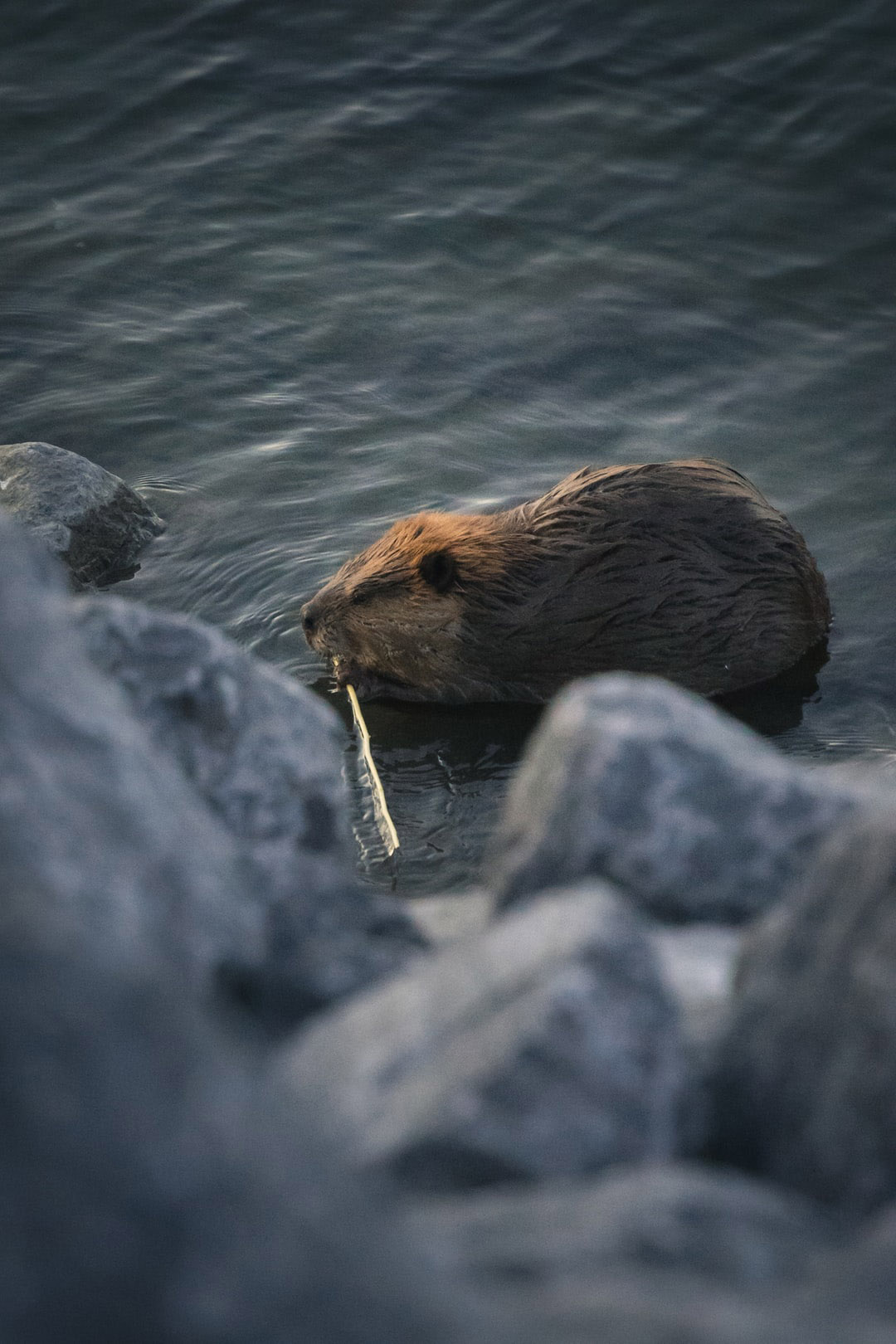
Watch this short film from "Beavers without borders" to find out how beavers can help us with the impacts of climate change, boosting biodiversity and creating a healthier, more balanced environment.
Watch video on YouTubeContact us
If you have any questions, please email [email protected]
